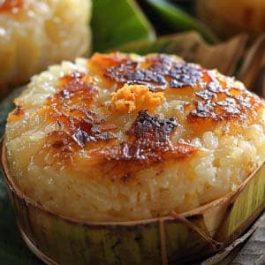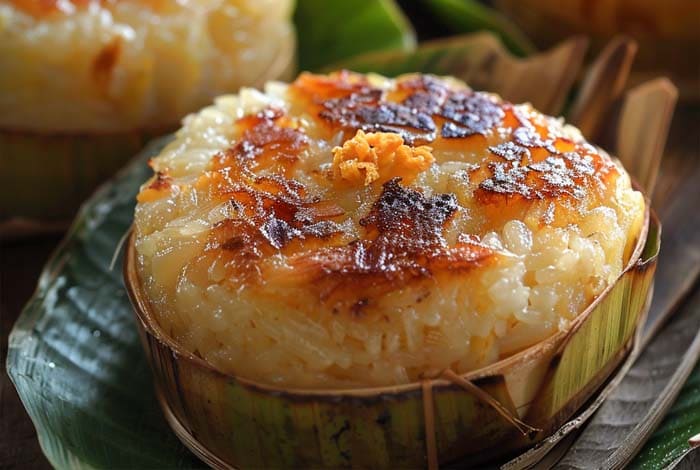Introduction to Bibingka
Bibingka is a quintessential Filipino delicacy, celebrated for its unique texture and flavor. It is a type of rice cake, made primarily from rice flour and coconut milk, that epitomizes the fusion of indigenous and colonial culinary traditions in the Philippines. Traditionally baked in banana leaves over charcoal, Bibingka exudes a smoky aroma that is as inviting as its buttery and slightly sweet taste.
This cake is not just a treat; it’s a cultural emblem that brings to light the Philippines’ rich history and diverse culinary landscape. Bibingka is most popular during the Christmas season, serving as a warm, comforting presence in the early morning hours after Simbang Gabi or Misa de Gallo, the nine-day series of masses leading up to Christmas day. This practice of eating Bibingka after mass has woven it into the fabric of Filipino Christmas traditions, making it a symbol of celebration, family, and community.
History of Bibingka
The origins of Bibingka can be traced back to pre-Hispanic times, influenced by the various trading activities in the Southeast Asian region. Its name is believed to have derived from the Hokkien word “beehkang,” which refers to a type of rice cake, indicating the influence of Chinese traders on Filipino cuisine. Over centuries, the recipe evolved, incorporating ingredients brought by Spanish colonizers, such as eggs and dairy, thus transforming it into the Bibingka we know today.
The traditional method of preparing Bibingka involves a labor-intensive process that speaks volumes of the Filipinos’ culinary ingenuity. The cake batter, made from a mixture of ground glutinous rice, coconut milk, and sugar, is poured into a pan lined with banana leaves for an added aroma and then baked using a unique method. Charcoal is placed both under and over the baking pan, ensuring an even cook and imbuing the cake with a distinct smoky flavor. Toppings such as salted egg, cheese, and grated coconut are added, enhancing its flavor profile and making each bite a delightful experience.
The evolution of Bibingka reflects the changes in Filipino society and culinary practices. From a simple rice cake to a festive treat adorned with a variety of toppings, it has become a staple at Christmas time, symbolizing joy, unity, and the warmth of Filipino hospitality. Despite the advent of modern cooking methods, the essence of Bibingka remains rooted in its traditional preparation, making it a timeless delicacy cherished by generations.
Ingredients and Equipment
Creating Bibingka, the beloved Filipino coconut rice cake, requires a mix of simple yet distinct ingredients. Here’s what you need:
- Rice Flour: The base of the cake, providing its unique texture.
- Coconut Milk: Infuses the cake with its signature creamy, tropical flavor.
- Sugar: Adds sweetness that complements the savory notes.
- Eggs: Help in binding the ingredients together and adding fluffiness to the cake.
- Baking Powder: A leavening agent that helps the cake rise.
Optional Toppings:
- Salted Duck Eggs: Adds a savory depth.
- Freshly Grated Cheese: Offers a salty, creamy contrast.
- Grated Coconut: Enhances the tropical flavor.
As for the equipment, the traditional and authentic way to bake Bibingka involves using banana leaves for lining the baking pan, imparting a distinct aroma and flavor to the cake. You’ll also need:
- A baking pan or muffin tins if you’re aiming for individual servings.
- A charcoal grill for traditional baking, although a regular oven works fine for home cooks.
These ingredients and tools come together to create a culinary experience that’s deeply rooted in Filipino tradition, offering a taste that’s both nostalgic and comforting.
Step-by-Step Recipe
Preparing Banana Leaves:
- Clean the leaves under warm water; then, gently pat them dry.
- To make them pliable and release their aroma, briefly pass them over an open flame or dip them in boiling water until they soften.
Mixing and Pouring the Batter:
- Combine the dry ingredients in one bowl.
- In another, whisk the wet ingredients until smooth.
- Gradually mix the dry ingredients into the wet mixture to form a smooth batter.
Baking Process:
- Preheat your oven (or prepare your charcoal grill).
- Pour the batter into the banana leaf-lined pan or muffin tins.
- Bake until the cake is firm and lightly golden on top, which usually takes around 20-25 minutes in an oven set at a moderate temperature.
Tips for Achieving the Perfect Texture:
- Ensure your banana leaves are well-prepared to avoid the batter sticking to the pan and to infuse the cake with that distinctive aroma.
- Keep an eye on the baking time and temperature; Bibingka is best enjoyed when it’s moist and slightly chewy rather than dry or overbaked.
- For a traditional touch, consider adding a charcoal element if using an oven by placing a tray of lit charcoal on the rack above the cake during the last few minutes of baking.
By following these steps and tips, you can recreate the warmth and joy of Filipino holiday celebrations, or any gathering, with the delightful taste of Bibingka.
Variations of Bibingka
Bibingka, the cherished Filipino coconut rice cake, enjoys numerous variations across the Philippines, each bringing its unique twist to the classic recipe. One notable variation is the Royal Bibingka from Vigan, Ilocos Sur. Unlike the traditional version, Royal Bibingka uses glutinous rice flour, resulting in a moister and denser cake. It’s also enriched with cheese, either on top or mixed into the batter, creating a delightful savory-sweet combination.
Other regional variations include:
- Bibingka Malagkit: Uses sticky rice, offering a chewier texture.
- Bibingka Cassava: Made from grated cassava root, for a denser and slightly different flavor profile.
Modern twists on Bibingka integrate ingredients and techniques from global cuisines, such as incorporating chocolate, blueberries, or even matcha for a contemporary flavor. Some innovative versions also explore vegan options, substituting coconut oil for butter and almond milk for coconut milk, catering to a wider audience with dietary restrictions.
Serving and Storage Tips
Serving Suggestions:
- Bibingka is traditionally served warm, straight from the oven, with a pat of butter melting on top. It can also be enjoyed cold, providing a different texture and taste experience.
- Serve with a side of grated coconut, a sprinkle of sugar, and slices of salted egg for an authentic Filipino treat.
Storage and Reheating Instructions:
- To store Bibingka, wrap it tightly in plastic wrap or place it in an airtight container to keep it from drying out. It can be stored in the refrigerator for up to 3 days.
- For reheating, briefly warm in the microwave for a few seconds until heated through. Alternatively, if you prefer a slightly crisp exterior, reheat it in a toaster oven or under a broiler for a couple of minutes.
Bibingka’s versatility in serving and storage makes it a convenient and delightful option for both immediate enjoyment and later indulgence.
Conclusion
Bibingka’s rich cultural heritage, combined with its delicious taste and versatility, has made it a beloved dish among Filipinos and food enthusiasts worldwide. Whether sticking to the traditional preparation methods or exploring modern variations, Bibingka offers a unique window into Filipino culinary traditions. From festive celebrations to everyday snacks, this coconut rice cake continues to warm hearts and bring smiles, one slice at a time.
FAQs
- Can Bibingka be frozen?
Yes, Bibingka can be frozen for longer storage. To do so, ensure it’s completely cooled, then wrap it tightly in plastic wrap or aluminum foil to prevent freezer burn. When properly stored, Bibingka can last in the freezer for up to 2 months. Thawing should be done gradually in the refrigerator before reheating. - How do you reheat Bibingka to maintain its texture?
Reheating Bibingka correctly is crucial to maintaining its texture. For the best results, reheat it in an oven at 350°F for about 10 minutes if it’s refrigerated or slightly longer if it’s been frozen and thawed. This method helps restore its original warmth and softness without drying it out. - Variations in cooking times based on different baking methods
Cooking times for Bibingka may vary based on the method used. Traditional clay ovens will have different heat distribution compared to modern ovens. As a general rule, Bibingka baked in a conventional oven at 350°F typically requires about 20-25 minutes. However, always check for doneness with a toothpick inserted into the center coming out clean. Adjustments should be made depending on your oven’s specifics and the size of the Bibingka.
Conclusion
Embracing the art of making Bibingka at home is not just about following a recipe; it’s an exploration of cultural heritage and culinary creativity. We encourage you to try making Bibingka, experimenting with both traditional and modern variations to find your perfect version. Whether you’re a seasoned baker or new to the kitchen, the process of baking Bibingka offers a rewarding experience filled with the rich flavors and traditions of the Philippines.
Share your Bibingka adventures with us! We’d love to hear about your experiences, any variations you’ve tried, and the memories you’ve created around this beloved dish. Your insights and innovations help keep the tradition alive and vibrant for future generations.

Bibingka (Coconut Rice Cake)
Equipment
- Baking pan
- Oven or Charcoal Grill
- Banana Leaves (for lining)
Ingredients
- 2 cups of rice flour
- 1 can 13.5 oz coconut milk
- 1 cup granulated sugar
- 4 large eggs
- 1/2 teaspoon baking powder
- Optional toppings: salted duck egg slices grated cheese, grated coconut
Instructions
- Prepare Banana Leaves: Clean and heat to make them pliable for lining the baking pan.
- Mix Batter: Combine dry ingredients, then mix in wet ingredients to form a smooth batter.
- Bake: Pour batter into the lined pan, add toppings if desired, and bake until golden.
- Serve: Enjoy warm, with additional grated coconut or cheese on top.
Notes
- For a more authentic taste, use freshly grated coconut milk.
- If banana leaves are unavailable, parchment paper can be used as a substitute, though the traditional aroma will be less pronounced.
- Adjust the amount of sugar based on your preference for sweetness.
- Bibingka is best enjoyed warm, but it can also be served at room temperature or even cold, offering a different texture and taste experience.

